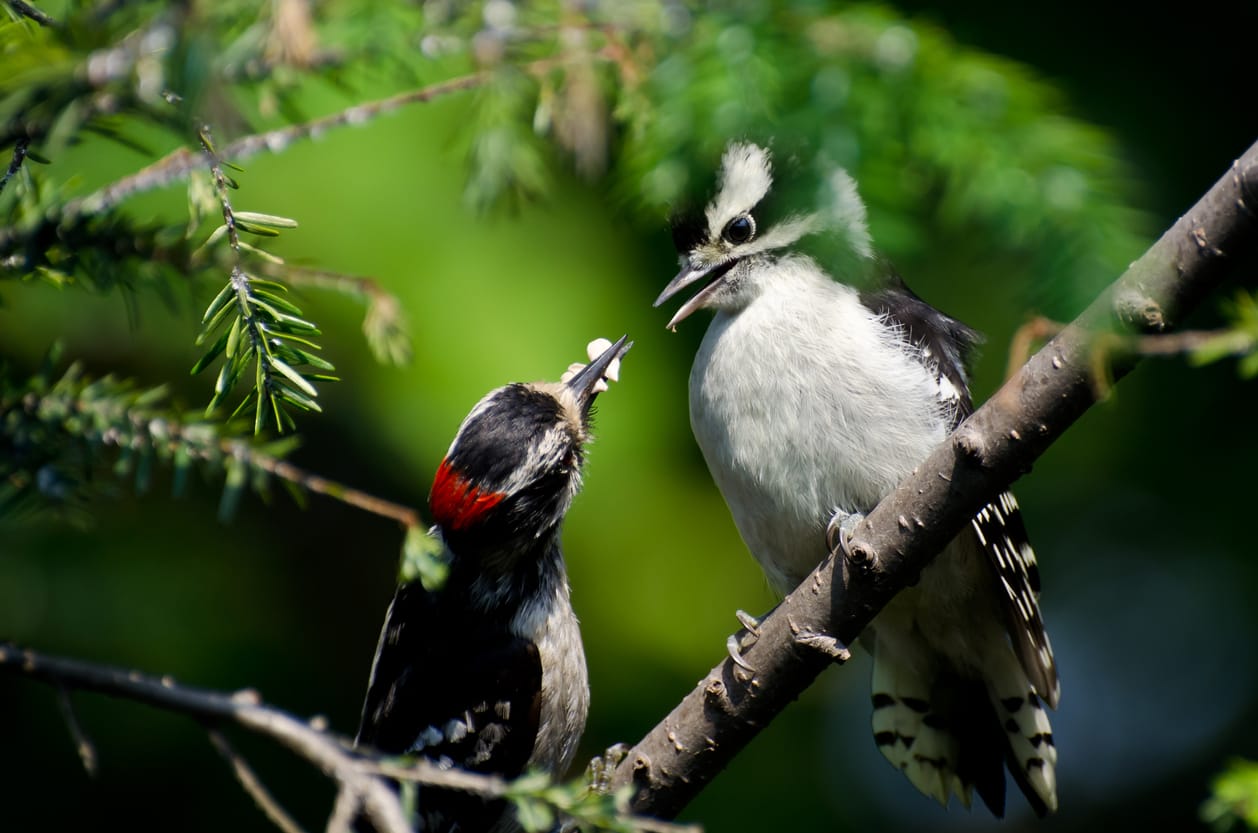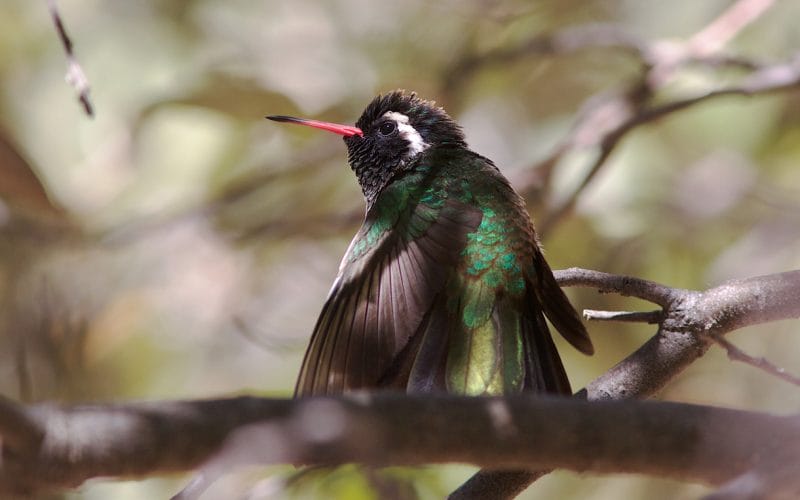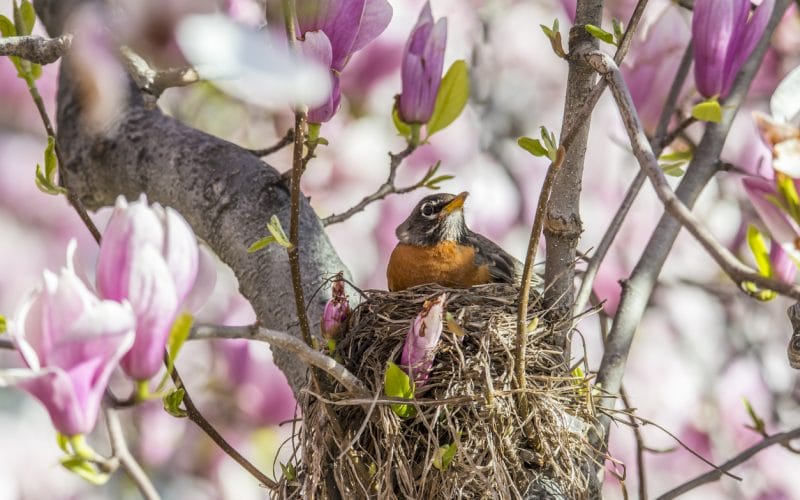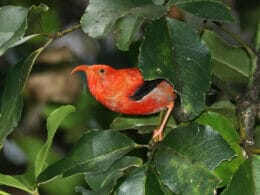Waking up to the sound of birds chirping can be delightful. Once you get out of bed and look through your backyard window, you might see a bird or two perched on a branch.
As a birding fan, you’d likely be able to identify their species. Nevertheless, if you’re still new to the game, getting to know their breed might be challenging at first, especially if you’re a Coloradan.
The Colorado region houses numerous types of birds in its inhabitants’ backyards. Stick around if you’re keen to know most of the backyard birds of Colorado.
11 Birds of Colorado
Numerous characteristics can help you identify the breed you see in your backyard.
Birds naturally jitter a lot and won’t exactly stand still. This might make it difficult to check their plumage or beak. Luckily, with more practice, you might be able to recognize the breed just from its sound.
1. Downy Woodpecker

Downy Woodpeckers are tiny birds almost the size of a sparrow. Since they’re woodpeckers, you’ll most likely find these small birdies pecking at a tree trunk, in search of their next critter meal.
If you’re trying to attract these birds to your backyard, then we recommend leaving out some black oil sunflower seeds or millet.
Author Note: Downy woodpeckers have a black and white color pattern. Their feathers are mostly black and covered with white checkered specks. Meanwhile, their chests are a blank white.
These Coloradan woodpeckers’ heads are thickly striped in black and white. The most distinct feature about the breed’s males is their statement red patch found at the back of their heads.
The bird’s beak is stiff and aligned like a nail, hard enough to break through the wood.
You can see downy woodpeckers flying in an up-down-up style. If you’re trying to listen to one, focus on their pecking noises. They also give out high-pitched yelps.
2. Black-capped Chickadee
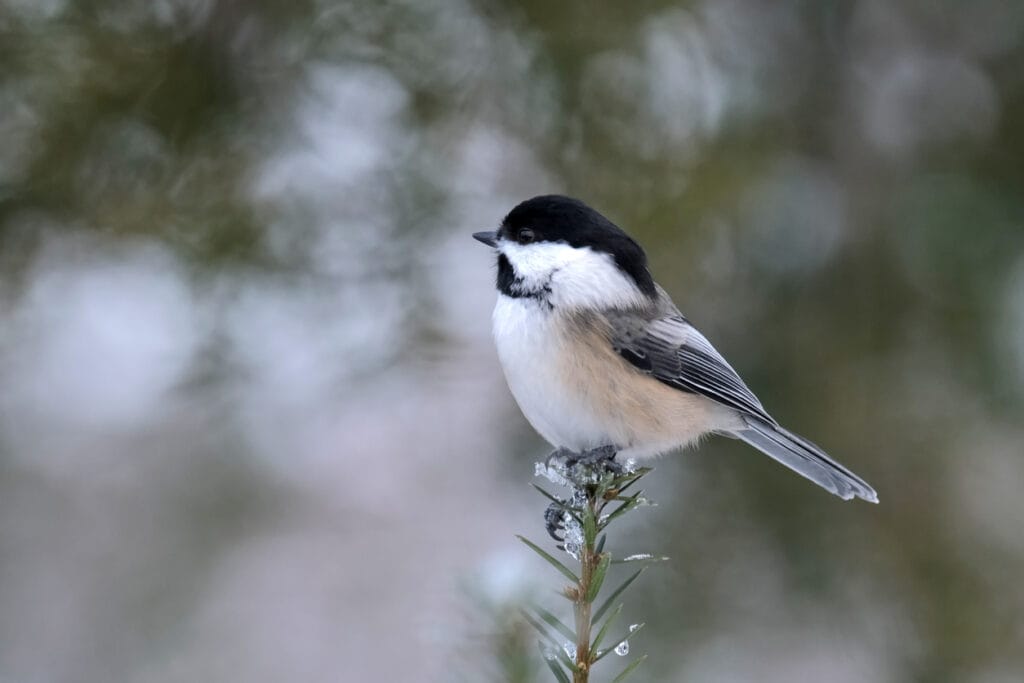
These might just be the most adorable breed on this list. Not only are they cute, but they’re also friendly birds.
It’s easy to lure in Black-capped Chickadees to your backyard. These birds will love seeing sunflower seeds and suet in your backyard. You can even try to attract Chickadees to your hands with a bit of peanut butter. In the wild, the breed feeds on insects and berries.
If you’re trying to build a home for the tiny songbirds, we’d recommend including wood shavings in their box.
Black-capped Chickadees are characterized by their circular shape and little black heads. Their cheeks are white and connect to a minuscule beak. They have grey feathered wings, a white chest, and black necks.
Their language is distinguishable by other species. Once they emit their warning predator calls, other bird species are responsive.
This breed, while common, is unique in its communication style. Did you know that the more prolonged the ‘dee’ note calls of Black-capped Chickadees are, the more dangerous the predator?
Apart from their ‘dee’ notes, the Chickadees also emit an alarming warbling sound whenever a lower-ranking bird approaches a high-ranking one.
3. House Finch
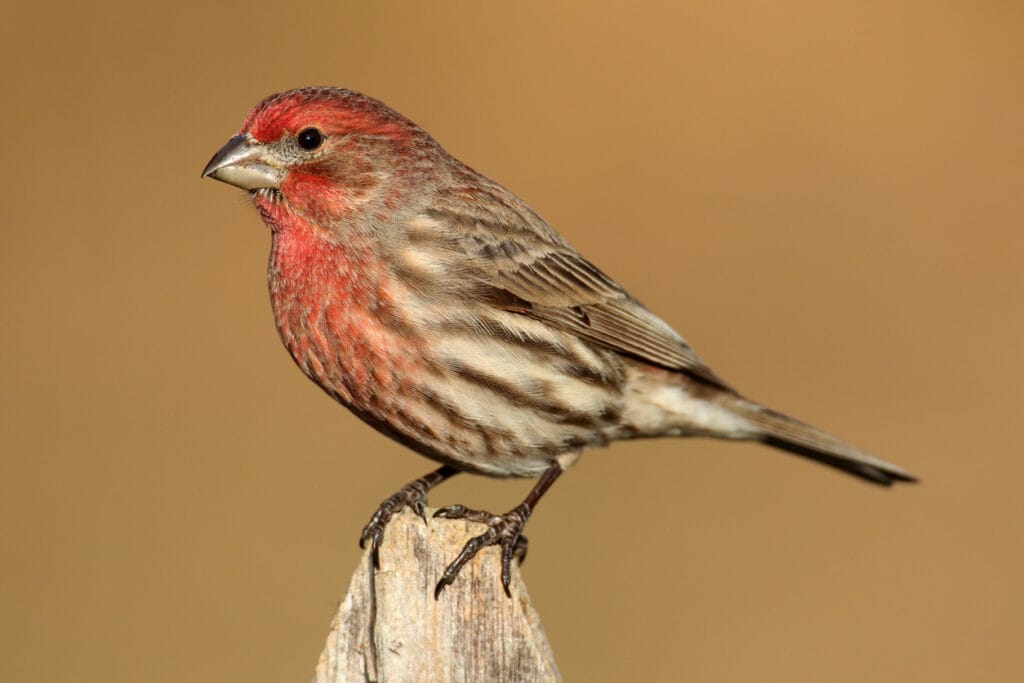
These Coloradan backyard birds are exceptionally social. They rarely migrate and prefer to settle in your backyards, parks, or the woods.
House Finches have different color patterns based on their gender. Male House Finches are more vibrant and noticeable with their red-covered upper chests and faces. However, the rest of their bodies are brownish-grey. Meanwhile, female House Finches are less flamboyant and have neutrally colored feathers.
The breed’s beak is cone-shaped so it can easily munch on its favorite grub, insects, and seeds. If you have any feeders around your Colorado backyard, you’re likely to see a flock of House Finches happily pecking around.
Top Tip: You can hear these finch species calling out in a “cheep” sound. If they’re converging off the ground, their notes are shriller. House Finches enjoy singing simple notes. Males warble out longer notes than female finches.
If you want to create a nesting region to attract House Finches, use twigs, leaves, and wool. You can form the nest into a cup shape to accommodate the tiny birds.
4. Mourning Dove

The breed’s name may seem uncharacteristic for a bird since they’re usually joyful creatures. Nevertheless, Mourning Doves derived their name from their unique sorrowful calls. Their sound is sometimes mistaken for an owl’s hooting.
They are a bit larger than the other backyard birds mentioned since they carry a 9 to 13-inch wingspan. When in flight, they give off a trilling noise. The doves fly straight and speedily.
You’ll likely find them around telephone wires. If not, they might be gathered in a large space, in groups, searching for food.
Mourning Doves aren’t gifted with a brightly-colored plumage. They are mostly grey and brown and have a few black dottings around their wings. You can easily identify Mourning Doves from the telltale black dot right under their eyes.
If you want Mourning Doves to grace your backyard, we recommend sprinkling millet around in your feeders. They particularly prefer to forage for their food on the ground. If you have any pets, then you might want to keep them inside because these doves are a likely target to your cats or dogs.
Mourning Doves are one of the main targets of hunters in the United States. Despite that, these dove species are still plentiful, with a population of over 350 million. That is roughly 20 million more than the country’s human inhabitants.
5. Northern Flicker

This Coloradan bird is slightly large. It’s almost the size of a crow. Although it is a woodpecker, you’ll mostly find this bird on the ground foraging for food.
Top Tip: To draw in a Northern Flicker, you can keep your backyard feeders on the ground. The woodpeckers can feed on black sunflower seeds and a variety of insects.
In Colorado, you’ll likely encounter the yellow-shafted variety of the species. The breed is adorned with a spotty black breast with a brownish background. It has a yellow tapered tail along with a red crescent on the back of its neck.
Northern Flickers are loud birds. Once you hear a rising clattering noise, you’ll know it’s this woodpecker. The calls usually last up to eight seconds. That being so, you’re most likely going to hear a Northern Flicker’s wood pecking sound more than its calling song.
6. American Robin
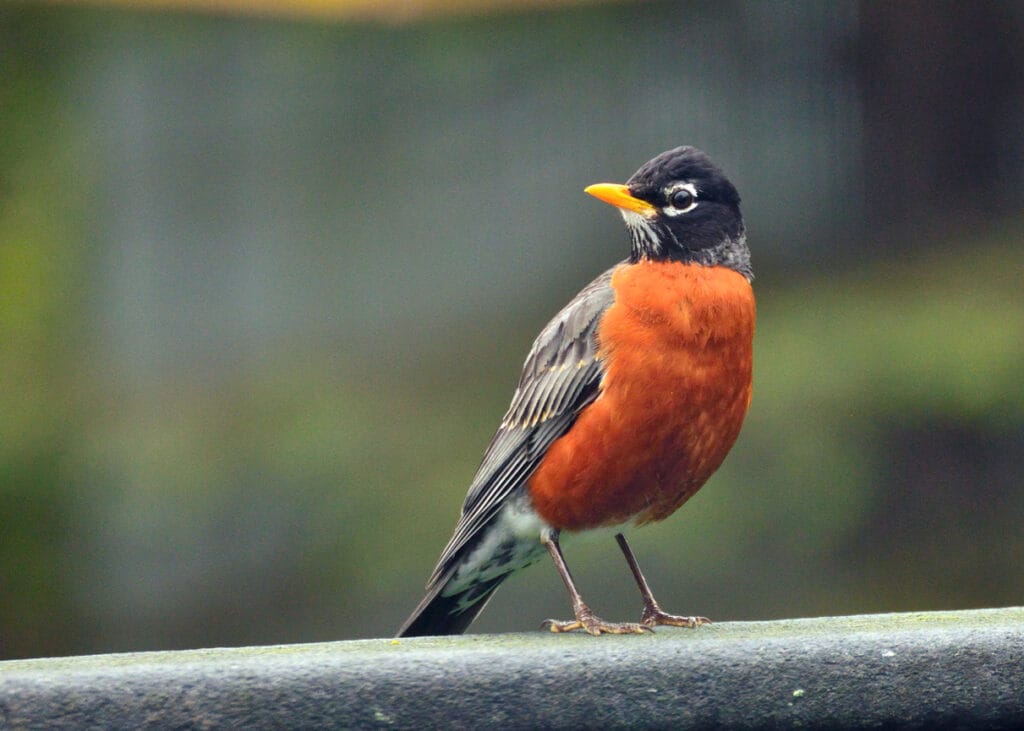
The possibilities are high when trying to spot an American Robin in your Coloradan backyard. These birds love hopping a visit to your lawn. If we can describe these songbirds in one word, it would be wholesome.
American Robins are little bundles of joy. They greet your morning with an exuberant tune. Hearing their songs will remind you of a bright day in spring. Nevertheless, if they sense a threat, they give off a high-pitched “yeep” sound to alarm their flock.
When it comes to their color pattern, American Robins have a warm orange-colored chest. Their heads are black, while the rest of their body is gray. The Robins’ beaks are a vibrant orange.
Speaking of beaks, American Robins are equipped with tiny ones fit to hunt for earthworms on your lawn. They’re also fond of snails, suet, sunflower seeds, and other insects. It won’t be hard to lure in American Robins to your backyard.
7. Black-billed Magpie
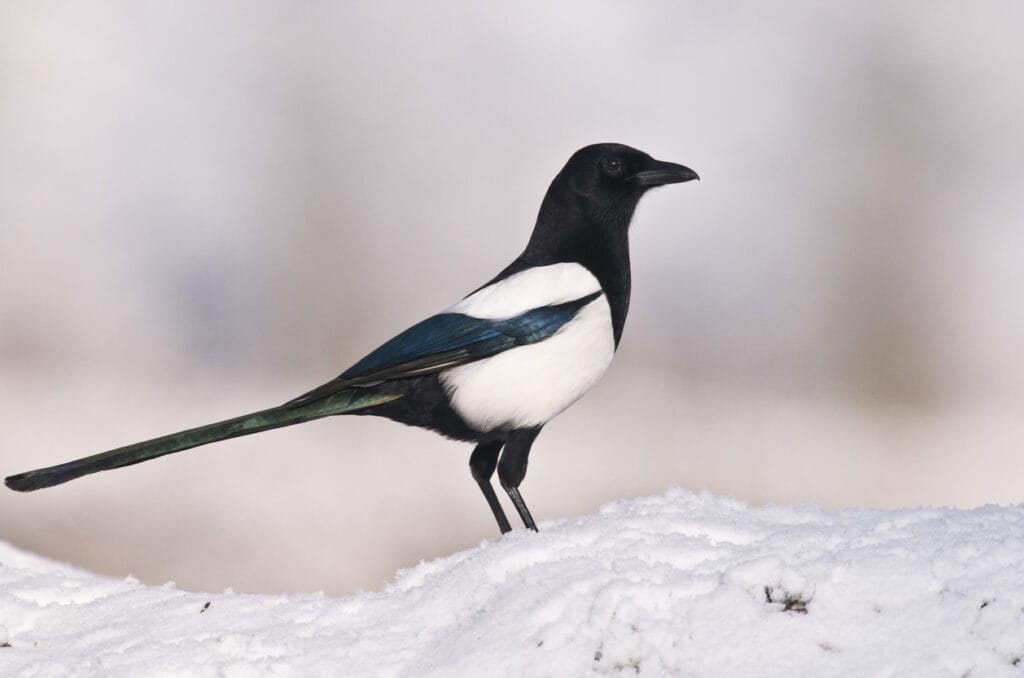
Black-billed Magpies are no strangers to aggression. While the breed looks harmless enough, it can take out a squirrel, so be warned. These opportunistic birds won’t turn their beaks up to roadkill.
Nevertheless, they’re undeniably pretty birds. Black-billed Magpies might seem black to an untrained eye, but their plumage is actually a lustrous green-blue color. The chest region is white, giving the bird a tuxedo look.
Top Tip: Black-billed Magpies are almost the same size as a crow. They have long tails with relatively short wings.
This breed isn’t blessed with a particularly pleasant call. Magpies sound like they’re cackling with a “wock-wock” noise.
If you’re trying to attract a Black-billed magpie to your backyard, add some fruit, suet, and millet. We advise you to be careful if you have nests in the area because the magpies can raid the eggs.
Interestingly, these birds have a complex set of social hierarchy rules, similar to crows. The dominant male establishes his power through a series of stretches and eyelid flashes.
8. White-breasted Nuthatch

The White-breasted Nuthatches are one of the smallest birds on this list. They are even smaller than a sparrow.
You can identify these birds from their black head and nape along with their white face and chest. Their under-the-tail plumage is a distinct chestnut color. The nuthatches’ wings and tails are a mix of gray and blue.
White-breasted Nuthatches are commonly found in trees, going through the bark to look for prey. They stand with their heads toward the ground.
Even though these birds seem frail, they can crack open nuts and acorns with their chisel-like beak.
You can put a platform or tube feeder for the nuthatches. Make sure to include peanuts and sunflower seeds.
If you’re trying to listen to a White-breasted Nuthatch, keep your ears open for that “wa-wa-wa” sound. The noise lasts for around three seconds or so.
9. American Goldfinch

American Goldfinches are almost everywhere in Colorado. Just look for a yellow-feathered little songbird. Although, these goldfinches aren’t always yellow.
These birds have two separate molting sessions per year, unlike most other finch species. Male breeding American Goldfinches change to a yellow color during late winter and late summer.
Female and non-breeding male American Goldfinches are brown with subtle hints of yellow. They have black and white wings. These finches have a conical brown and sometimes orange beak.
The best way to get American Goldfinches in your backyard is through planting thistle and milkweed. They also enjoy pecking on insects, seeds, and nyjer.
Listening to American Goldfinches sing is a true delight. They let out a string of warbles and tweets. They also have an alarm call when threatened that’s two-noted and sounds like “bay-bee.”
10. Broad-tailed Hummingbird

Despite hummingbirds being known for their petiteness, the Broad-tailed Hummingbird is on the larger scale of this breed in North America. Its tail is considerably longer as well.
Broad-tailed Hummingbirds are something out of a fairytale. Males are adorned with a mesmerizing mauvish-magenta gorget. They have glowing green heads and white chests. Their wing plumage is also green with additional brown streaks.
These backyard birds might be a bit trickier to attract since they’re more commonly found in highly elevated areas. That being said, you can try installing a tube feeder and filling it with sugar water.
Hummingbirds are most fond of nectar. They drink from larkspur, scarlet gilia, and red columbine using their narrow beaks. Planting those will give you a higher chance of Broad-tailed Hummingbird guests.
These hummingbirds give off a cricket-like sound. You can hear them best when they’re in flight. Their chirping sounds are loud for such a small creature.
11. Common Grackle

Common Grackles are a bit larger than your average blackbird. They have longer beaks and tails, as well.
Male Common Grackles may seem black at first but are actually tinged with a mixture of iridescent blue, bronze, and purple.
Imagine walking into an old abandoned house and knocking on the door, which croaks slightly ajar. That’s what a Common Grackle sounds like. It’s not the most pleasant of sounds, but we believe it makes up for its convenience.
Author Note: Common Grackles can act as a natural insect repellent to protect your plants. They can also eat your garbage. Apart from that, they can eat seeds and nuts off of a platform feeder.
This breed is also found to participate in anting. They unfurl their wings on the floor and lean over to let ants cover their bodies. While it may seem like the beginning of a horror flick, it’s for their benefit.
The chemical in the ant stings, formic acid, reduces the risk of parasite contraction. This protects Common Grackles from any harmful diseases.
To Conclude
Backyard birds of Colorado come in all forms and sounds. Most breeds are enticed through simple feeders filled with seeds and suet. With a few of those installed, you’re bound to find a fleet of these backyard birds coming for a visit.
Whether you relish the sing-song of birds in the morning or love birding, your Coloradan lawn could be home for some of these fascinating and adorable breeds.
FAQ
The most common bird in Colorado is the American Robin. Other common bird species in Colorado include the Mountain Bluebird, Dark-eyed Junco, Western Bluebird, Black-billed Magpie, Western Tanager, and Steller’s Jay.
There are several species of yellow birds that can be found in Colorado, including the American Goldfinch, Western Tanager, Yellow Warbler, Wilson’s Warbler, and Yellow-rumped Warbler. These birds have bright yellow head, body, and/or rump, with different coloration on their wings, tails, and heads.
The black and white birds commonly seen in Colorado are the Black-billed Magpie, which has distinctive black and white feathers.
Some of the bird species native to Denver, Colorado include the American Goldfinch, Northern Flicker, Rock Pigeon, and Black-crowned Night-Heron. The city of Denver is also located near the Rocky Mountains, which provides habitat for a wide variety of bird species, including the Mountain Bluebird and Western Bluebird.




